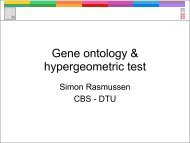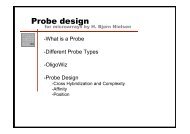Computational tools and Interoperability in Comparative ... - CBS
Computational tools and Interoperability in Comparative ... - CBS
Computational tools and Interoperability in Comparative ... - CBS
You also want an ePaper? Increase the reach of your titles
YUMPU automatically turns print PDFs into web optimized ePapers that Google loves.
8 O. N. Reva et al.<br />
compiled <strong>in</strong>to a structural profile of all upstream regions of<br />
A. borkumensis (see section Experimental procedures).<br />
The profile uses z-scores to measure how the average<br />
value of the properties vary from m<strong>in</strong>us 400 bp to 400 bp<br />
around the translation start (Fig. 7). A. borkumensis has<br />
only a cod<strong>in</strong>g density of 87% caus<strong>in</strong>g a wider spacer of<br />
the <strong>in</strong>tergenic region <strong>and</strong> this appears to give rise to a<br />
larger <strong>and</strong> wider peak of curvature, stack<strong>in</strong>g energy <strong>and</strong><br />
AT content (Fig. 7A). For comparison we also analysed<br />
the promoter profile of another ocean bacterium, C<strong>and</strong>idatus<br />
Pelagibacter ubique HTCC1062 (Giovannoni et al.,<br />
2005), an example of a highly streaml<strong>in</strong>ed genome with a<br />
cod<strong>in</strong>g density of 96%. Here we observed a much weaker<br />
curvature signal, <strong>and</strong> the distribution of stack<strong>in</strong>g energy<br />
<strong>and</strong> AT content was more narrow <strong>and</strong> had higher maxima<br />
(Fig. 7B).<br />
Next, the probability of open<strong>in</strong>g dur<strong>in</strong>g stress-<strong>in</strong>duced<br />
DNA duplex destabilization was computed by us<strong>in</strong>g the<br />
program SIDD (Wang et al., 2004), cover<strong>in</strong>g five different<br />
values of the super-helical density s = {-0.025, -0.035,<br />
-0.045, -0.055, -0.065}. As super-coil<strong>in</strong>g is be<strong>in</strong>g<br />
pushed, the probability of open<strong>in</strong>g <strong>in</strong>creases at lower<br />
super-helical densities <strong>in</strong> A. borkumensis (Fig. 7C). In<br />
contrast, a narrower SIDD profile that exhibits only<br />
m<strong>in</strong>or dependence on super-helical density (Fig. 7D),<br />
was calculated for the C<strong>and</strong>idatus Pelagibacter ubique<br />
HTCC1062 genome.<br />
The structural profile for the promoter regions of<br />
A. borkumensis was compared with that of closely related<br />
species as found above (see Fig. 4). Generally, it looked<br />
more like the promoter profile of members of the<br />
Pseudomonadales than the general comparison organism,<br />
E. coli. Moreover, the promoter profile was very different<br />
compared with the promoter profile of X. fastidiosa<br />
stra<strong>in</strong>s, even though they where very similar with regard<br />
to their TU profile (see Fig. 4). The promoter profiles for<br />
the above mentioned organisms may be found at our<br />
website (http://www.cbs.dtu.dk/services/GenomeAtlas/).<br />
Am<strong>in</strong>o acid <strong>and</strong> codon usage<br />
We have exam<strong>in</strong>ed the codon <strong>and</strong> am<strong>in</strong>o acid usage of<br />
A. borkumensis <strong>and</strong> compared this with both the usage of<br />
bacteria <strong>in</strong> general <strong>and</strong> of 16 oceanic bacteria (Entrez<br />
project IDs 230, 10 645, 12 530, 13 233, 13 239, 13 282,<br />
13 642, 13 643, 13 654, 13 655, 13 902, 13 906, 13 910,<br />
13 911, 13 989, 15 660) Willenbrock et al., 2006). In<br />
Fig. 8, the codon usage plot of A. borkumensis is<br />
superimposed on the cumulative plot of all completely<br />
sequenced bacteria <strong>in</strong> public databases (N = 518,<br />
Fig. 8A) or of that of 16 oceanic bacteria (Fig. 8B).<br />
A few codons are differentially utilized <strong>in</strong> A. borkumensis<br />
(GUC, CUG), but all values are with<strong>in</strong> the range of three<br />
st<strong>and</strong>ard deviations. In other words, codon usage of<br />
A. borkumensis resides with<strong>in</strong> the typical range of<br />
eubacteria.<br />
Interest<strong>in</strong>gly, the sequenced oceanic bacteria share a<br />
very similar am<strong>in</strong>o acid usage (Fig. 8D), whereas broad<br />
variations thereof were noted amongst all sequenced<br />
bacteria that represent the whole spectrum of habitats<br />
(Fig. 8C). A. borkumensis roughly follows the profile of the<br />
oceanic bacteria, although cyste<strong>in</strong>e, tryptophan, leuc<strong>in</strong>e,<br />
prol<strong>in</strong>e, arg<strong>in</strong><strong>in</strong>e, ser<strong>in</strong>e are under-utilized, <strong>and</strong> glutamic<br />
acid, lys<strong>in</strong>e, phenylalan<strong>in</strong>e, histid<strong>in</strong>e, methion<strong>in</strong>e, <strong>and</strong><br />
tyros<strong>in</strong>e are over-utilized – all exceed<strong>in</strong>g the threest<strong>and</strong>ard<br />
deviation boundaries.<br />
Conclusion<br />
Fig. 7. Profile of structural properties of<br />
promoter regions (A <strong>and</strong> B) <strong>and</strong> probabilities<br />
of open<strong>in</strong>g dur<strong>in</strong>g stress-<strong>in</strong>duced DNA duplex<br />
destabilization at various super-helical<br />
densities (C <strong>and</strong> D) <strong>in</strong> the A. borkumensis<br />
SK2 (A <strong>and</strong> C) <strong>and</strong> C<strong>and</strong>idatus Pelagibacter<br />
ubique HTCC1062 (B <strong>and</strong> D) chromosomes.<br />
Each annotated gene was aligned at the<br />
translation start site <strong>and</strong> the average values<br />
for the SIDD probabilities, AT-content, position<br />
preference, stack<strong>in</strong>g energy, <strong>in</strong>tr<strong>in</strong>sic<br />
curvature <strong>and</strong> DNase sensitivity were<br />
calculated at each position <strong>in</strong> the alignment.<br />
The values were subsequently converted <strong>in</strong>to<br />
z-scores, us<strong>in</strong>g the average <strong>and</strong> st<strong>and</strong>ard<br />
deviation of the entire chromosome. Values<br />
are smoothed over a 5 bp w<strong>in</strong>dow.<br />
Inspection of the collected phylogenetic connections<br />
revealed that the most closely related organisms are<br />
Ac<strong>in</strong>etobacter sp. <strong>and</strong> Pseudomonas aerug<strong>in</strong>osa,<br />
©2007TheAuthors<br />
Journal compilation © 2007 Society for Applied Microbiology <strong>and</strong> Blackwell Publish<strong>in</strong>g Ltd, Environmental Microbiology









